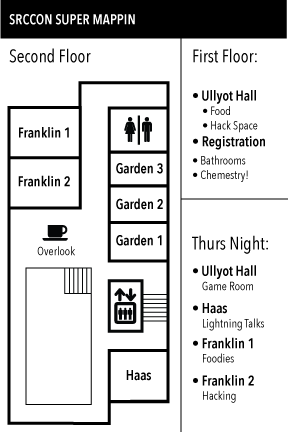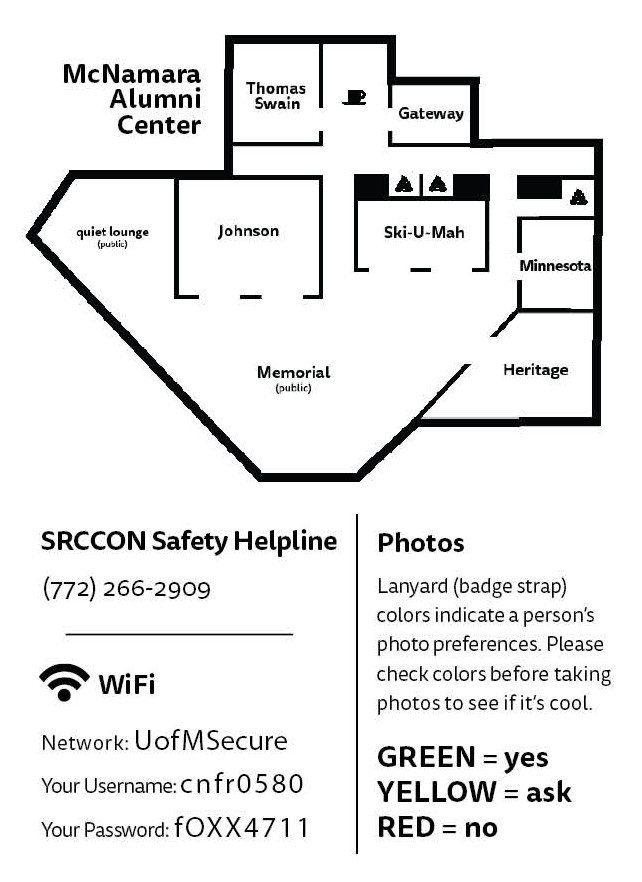The parts of SRCCON that can be copied by other conferences
- Notes and post-conference writeups
- Transcripts
- Long breaks between sessions
- Food
- Badges
- In conclusion
The first draft of this post was written on a plane between Minneapolis and Chicago, on not enough hours of sleep. Then there were drafts, and WordCamp for Publishers, but most of the bones of this were laid down in the days immediately after
The two days of SRCCON were full of amazing conversations, interesting sessions, and blesséd quiet time. This happy occasion was made possble by a number of factors, many of which can probably be adopted by other conferences.
Here's what I'm not going to talk about:
- Conference size or session size: That's up to what audience your conference serves and how many people you have.
- Inclusivity or codes of conduct: Other people have written at length about why you need those at your conferences. Read them.
- Lectures vs conversations: Your conference format is not something that is easily changed and is also heavily dependent upon the subject.
I'm here to talk about notes, transcripts, breaks, food, and badges. Each section will include prompts for discussion, if you're using this to plan a conference.
Notes and post-conference writeups
SRCCON keeps the number of simultaneous sessions low. Keeping the number of simultaneous sessions low reduces FOMO. But if you can't keep the number of parallel sessions low, you can allow people to attend sessions after they run.
How do you allow time-travelers to attend sessions? Through tipsheets, notes, video or audio recordings, transcripts, and writeups.
Sometimes attendees collect resources on their own. Encourage this! An excellent example of this is the NICAR link lists like this one that Chrys Wu makes.
What does it look like when a conference encourages guests to take notes together? It looks like a "Session notes and resources" link on session description pages, and an shared document that people contribute to. Sometimes very little gets written. Sometimes it's just a link from the person leading the session. Sometimes you get a lot of people typing at once. Massively collaborative note-taking doesn't always fit with a particular session, but having the infrastructure in place is a good idea. It requires a place to take notes and a way to link from the schedule to those notes.
Question: What infrastructure would your conference need to set up in order to encourage SRCCON-style collaborative note-taking?
Question: What does your conference do with its schedule after the conference is over? Do you update it with links to resources, or does it get abandoned? Does the schedule exist in a way that can be archived?
Question: Should your schedule be online, offline, or both?
- How does an online schedule work if internet dies in the venue, if the conference wifi can't keep up with the demands of a thousand people, if the conference venue is a concrete-and-steel Faraday cage and no one inside the venue has cellular access? Are your attendees willing to pay for conference wifi?
- How does your organization handle updating an offline schedule when a session needs to change?
- How do you link from offline schedules to online resources, and vice-versa?
Transcripts
Your conference should have live transcription (Communication Access Real-time Translation/CART) at your conferences, for the deaf, for the hard-of-hearing, and for people who can't hear the presenter over the room's noise,
If you have live transcription, try to publish the transcripts online to allow people to attend the conference without physically being present at the conference. Live transcripts are often raw and contain typos. It's perfectly okay to link to those on the day of the event; if you want you can clean up the transcript later. And it's okay to do post-session writeups that draw from the notes and the slides and an interview with the facilitator.
One example not enough? Session description, transcript, notes, moar notes, writeup.
Question: What would it take for your conference to have transcription? Have people asked for transcription in the past? Would you cover the whole conference or just certain sessions?
Question: Do conferences that have live transcripts online track the number of remote attendees? Do those conferences ask remote attendees for feedback in the way they ask in-person attendees?
Long breaks between sessions
SRCCON's inter-session breaks are 30 minutes, as opposed to 10 or 15 at other conferences. This serves a few purposes:
- longer bathroom breaks
- snack time, rehydration time, and stretch time
- sessions can run a little over without taking setup time from the next session
- more time to move between sessions and get set up
- more time to finish session follow-up conversations
Read this Quartz article about the Japanese words for space and pay attention to the "Negative space (ma)" section:
The ma at this event is awful! There’s no time to think or breathe in between the presentations, networking, and meals.
Questions: How long are your breaks? What's the optimum ratio of session-time to break-time?
Food
When SRCCON serves breakfast, it gets most everyone to the venue in time for the first session, and provides an opportunity for socializing before the day kicks in.
Serving lunch keeps everyone at the venue between the morning and evening sessions. It prolongs the so-called "hallway track" of the conference by the length of lunch. I've seen this at SRCCON and at WordCamps.
It's also a major logistical problem. Most conferences end up providing with-meat, kosher, vegetarian and vegan options.
Question: Where are the nearest restaurants and food sources to your conference venue? Where do they fall on the price scale? Can a government official on per-diem rates both attend your conference and eat?
Question: If you already provide one meal for your conference, what's preventing you from providing more than one? How many meals would typically be consumed during your conference? How will you handle dietary restrictions, or people who have non-default meal cycles?
Question: If you provide coffee, what other beverages will you provide? Will you provide hot water for tea? What other freebies are you providing? Are there tampons, pads, sanitary napkins, toothbrushes, toothpaste, floss, and so on in the bathrooms?
Question: Do you have a lactation room for breast-feeding parents? Is it well-equipped and near the conference venue? Does your conference offer child care?
Question: If you have an open bar, or a token bar, what are you providing for the people who don't drink? What else is going on during that time?
Badges
This is the last section of this blog post, and the longest, for something that is arguably the smallest thing at a conference.
The barest-minimum conference badge is a sticky label with your name written upon it. Most conferences go beyond that. Here's a sample of all the event-specific nametags that I have lying around:
- event branding, attendee name, attendee organization
- event branding, attendee name, event location
- event branding, attendee name, attendee organization
- event branding, attendee name, attendee organization
- event branding, attendee name, attendee organization
- event branding, location, date, website url, event logistics company branding
- event branding, attendee name, event dates, event location.
- attendee photo, attendee name, attendee role, attendee access level, attendee phone number
- event branding, attendee name, attendee access level
- event branding, attendee name, attendee access level, QR code for an ARG
- event branding, attendee access level
- event branding, attendee access level
- event branding, attendee name, wifi password, event emergency procedures, event venue map
The most common thing here is the attendee's name and the event branding.
Question: What's on your conference's badges?
In professional contexts, the attendee's organization or employer is often included, but not always. SRCCON explicitly excludes the organization in order to foster a sense of community.
In contexts where there's a distinction between type of attendees — speakers have access to a lounge, preregistered attendees have provided lunch, some ticket-holders have paid for backstage access, this ticket only valid for Saturday — the badges display that information. The information is displayed in different ways: a sticker, a special badge design, a badge ribbon.
In the realm of badge accessories, SRCCON provided pronoun pins for attendees. Badges have people's names; pronoun pins contain related information on who people are.
Rarely have I seen cases where event organizers' status is marked on the badge. Here's what I've seen:
- At SRCCON, organizers had one color t-shirt, volunteers a second color, and then attendees have neither t-shirt. (SRCCON volunteers receive two t-shirts, so they have a clean one for each day. Not all hotels have affordable laundry service.)
- At WordCamp for Publishers, organizers and volunteers had the same shirt.
- At one professional conference, organizers had stick-on badge ribbons; I assume that they would not wear a t-shirt to that event.
- At a very informal conference, organizers had a t-shirt, but the number of organizers emeritus was so high that active staff had a specific badge, to distinguish them from people who had the staff t-shirt but were not staff.
- At another informal conference, staff had a particularly silly hat.
You can put the organizer or volunteer status on the badge, but you don't have to. There are other ways.
Question: How are your conference's staff distinguished from your attendees? Is that distinction clear?
But of all the badges I've seen, SRCCON has the most-interesting badge. Not only does it have the usual items, it has a map of the venue. This worked well for the venues they used in 2014, 2015, and 2017, where the conference was mainly on one floor.


What do you do if your conference map doesn't fit on the back of the badge? Erika Owens, deputy director of Open News, writes: "In 2016, the rooms were all over the place, so Dan designed a sort of 'tabloid newspaper' version of the map so you could really open it up and see the layout." Dan Sinker, director of OpenNews, writes: "As Erika said, the complicated, multi-floor layout of Portland made a badge map impossible, and so we went with wall maps for people to do wayfinding with."
This makes sense to me; it's always right in front of the person. The way that SRCCON's badge attaches to its lanyard (clips at the upper corners) means that it isn't likely to accidentally flip over, so it can have a defined front and back side, with the back side being for the attendee and the front side being for the public.
Question: What information should your badge convey? Who is the audience for the badge?
Question: Do badges have to be the same on both sides?
In conclusion
Encourage attendees to take notes publicly. Make it easy for them to do so.
Have live transcripts of sessions, and post them online.
Have breaks between sessions.
Serve food.
Experiment with badges having more than just event branding and attendee name.
Shoutout to Erika Owens and Dan Sinker of OpenNews for their help in acquiring SRCCON badge designs. Thanks to Parker Higgins for splitting a hotel room with me at SRCCON, and to Pantheon for the travel scholarship to WordCamp for Publishers.
Updates:
- 2018-01-20
- Added link to qz.com/1181019/the-japanese-words-for-space-could-change-your-view-of-the-world/
- Added breast-feeding and child care questions